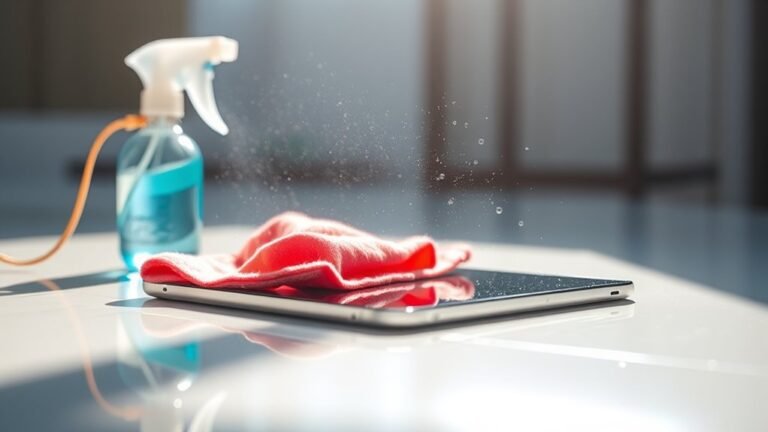Essential Tools for Cleaning Printer
You’ll want soft brushes and compressed air canisters to gently remove dust without damaging delicate parts. Use lint-free cloths and cotton swabs for precise cleaning, especially in tight spots. Eco-friendly cleaning solutions or isopropyl alcohol work well on ink residue—just apply them sparingly on cloths, never directly. Wearing gloves protects your hands and keeps oils off printer components. Equipped with these tools, you’re ready for effective printer maintenance. Keep exploring to uncover tips for ideal care and longevity.
Cleaning Solutions and Fluids

When you’re cleaning your printer, choosing the right cleaning solution is essential to avoid damage and guarantee effective results. You don’t have to rely on harsh chemicals; eco friendly solutions are just as effective and kinder to the environment. Simple homemade cleaners, like a mix of distilled water and isopropyl alcohol, can safely remove dust and ink residue without harming your printer’s delicate parts. Avoid abrasive or ammonia-based products, which can cause long-term damage. Using these gentle yet efficient fluids lets you maintain your printer’s performance while staying aligned with your values of freedom and sustainability. Always apply the solution sparingly on a lint-free cloth, never directly onto the printer. This careful approach keeps your device clean and running smoothly without compromising your health or the planet.
Soft Brushes for Dust Removal
You’ll want to choose soft brushes with fine bristles to gently remove dust without damaging delicate printer parts. Using light, sweeping motions helps prevent pushing debris deeper into the machine. Let’s explore the best types of brushes and how to use them effectively.
Types of Soft Brushes
Although dust may seem harmless, it can cause significant issues inside your printer if not removed properly. Choosing the right soft brush is essential for effective cleaning. Brushes come in various brush materials like natural bristles, synthetic fibers, and antistatic options. Natural bristles are gentle and great for delicate parts, while synthetic fibers offer durability and resistance to wear. Antistatic brushes prevent static buildup, protecting sensitive components. Brush sizes also vary—from small, fine-tipped brushes for tight spaces to larger ones for broader surfaces. Selecting the appropriate brush size guarantees you reach every nook without causing damage. By understanding these types, you gain the freedom to maintain your printer efficiently, extending its life and keeping your prints flawless.
Proper Dusting Techniques
Mastering three key dusting techniques will help you clean your printer effectively with soft brushes. First, choose the right duster types—use a fine, soft-bristle brush for delicate parts and a slightly firmer brush for larger surfaces. Second, employ gentle, sweeping motions to dislodge dust without damaging components. Third, always work from top to bottom, preventing recontamination of cleaned areas. Understanding cleaning frequency is vital; dust your printer weekly if it’s in a dusty environment, or biweekly otherwise. Regular dusting prevents buildup, ensuring peak printer performance and longevity. By integrating these proper dusting techniques with the correct soft brushes, you maintain your printer’s freedom from debris, reducing maintenance needs and extending its life without hassle or damage.
Lint-Free Cloths and Wipes

A lint-free cloth is essential for keeping your printer clean without leaving behind fibers that can cause jams or smudges. You’ll appreciate the lint free benefits—it guarantees a spotless surface and prevents damage. Using the right cleaning techniques, like gentle wiping and avoiding excessive moisture, keeps your printer running smoothly.
| Feature | Benefit |
|---|---|
| Lint-free fabric | No fibers left behind |
| Soft texture | Prevents scratches |
| Reusable | Eco-friendly and cost-effective |
| Easy to handle | Reaches tight printer parts |
| Compatible wipes | Safe for electronics |
Choose lint-free cloths and wipes to maintain freedom from printer issues while guaranteeing crisp, clean prints every time.
Compressed Air Canisters
Keeping your printer’s surface clean with lint-free cloths is just one part of maintenance; you’ll also want to tackle dust and debris in hard-to-reach areas. Compressed air canisters offer a simple, effective way to do this. The compressed air benefits include safely blowing out dust from inside your printer without touching delicate components. To make the most of compressed air, use it in short bursts, holding the can upright to avoid moisture build-up. Avoid shaking the can before use, and keep the nozzle a few inches away to prevent damage. Proper usage guarantees you clear dust and debris without pushing particles further inside. Using compressed air regularly helps maintain your printer’s performance and extends its lifespan, giving you the freedom to print smoothly whenever you need.
Cotton Swabs for Detailed Cleaning

When you need to clean tight spots inside your printer, cotton swabs offer precise control without risking damage. Choosing swabs made from soft, lint-free materials helps protect delicate components while removing dust and ink residue. Using the right swabs guarantees your printer stays clean and functions smoothly.
Precision Cleaning Benefits
Although cleaning a printer may seem straightforward, achieving precision requires the right tools—cotton swabs are perfect for this task. When you use cotton swabs, you gain precision cleaning advantages that simple cloths or brushes can’t offer. Their small size and soft texture let you reach tight spaces without causing damage. Employing precision cleaning techniques with cotton swabs helps remove dust, ink residue, and debris exactly where it accumulates, ensuring your printer runs smoothly. This focused approach minimizes the risk of missed spots and maintains peak print quality. By incorporating cotton swabs into your cleaning routine, you gain better control and efficiency, giving you the freedom to keep your printer in top shape without hassle or guesswork.
Avoiding Printer Damage
Since printers have delicate components, using the wrong cleaning tools can easily cause damage. When you’re handling detailed cleaning, cotton swabs are a smart choice. They allow you to reach tight spaces without scratching surfaces or disrupting sensitive parts. To protect your investment, remember these printer maintenance tips:
- Use high-quality cotton swabs designed for electronics to avoid leaving fibers behind.
- Apply minimal pressure to prevent dislodging or damaging tiny components.
- Pair swabs with approved printer care products, like isopropyl alcohol, for effective yet gentle cleaning.
Best Swab Materials
Choosing the right swab material is key to cleaning your printer effectively without causing damage. Cotton swabs are a popular choice due to their softness and precision, allowing you to reach tight spaces without scratching delicate parts. When selecting swab materials, opt for high-quality, lint-free cotton to avoid leaving fibers behind that could impair printer function. Some swabs come with wooden or plastic handles; pick what feels sturdy and easy to maneuver. Avoid overly abrasive or synthetic swabs, as they might reduce cleaning effectiveness or harm your printer’s components. By choosing the appropriate swab materials, you guarantee thorough cleaning with minimal risk, giving you control and freedom to maintain your printer’s performance effortlessly.
Gloves and Protective Gear
When you’re cleaning printers, wearing gloves and protective gear is vital to keep your hands safe from ink, chemicals, and sharp parts. Following proper safety protocols not only protects you but also guarantees the cleaning process goes smoothly without contamination or injury. Choosing the right materials for gloves and gear is essential for comfort and durability.
Consider these essentials:
- Nitrile gloves for chemical resistance and flexibility
- Safety goggles to protect your eyes from splashes
- Long-sleeve protective clothing to shield your skin from sharp edges and ink stains
Frequently Asked Questions
How Often Should I Clean My Printer to Maintain Optimal Performance?
You should set a regular cleaning frequency to keep your printer running smoothly. For most users, cleaning your printer every three to six months strikes a good balance between performance and convenience. If you print frequently or notice quality issues, consider cleaning more often. Consistent printer maintenance helps prevent clogs and extends your device’s life, giving you the freedom to print without interruptions or costly repairs.
Can Using the Wrong Cleaning Tools Damage My Printer?
Think of your printer as a delicate dance partner—using the wrong cleaning supplies can step on its toes, causing damage. If you’re not careful, harsh chemicals or rough tools can scratch surfaces or clog mechanisms, disrupting printer maintenance and cutting your freedom to print smoothly. Stick to recommended supplies to keep your device humming effortlessly, so you’re always free to create without worrying about costly repairs or downtime.
Are There Any Eco-Friendly Alternatives for Printer Cleaning Products?
You can definitely find eco friendly solutions for cleaning your printer that align with sustainable practices. Instead of harsh chemicals, try diluted white vinegar or gentle, plant-based cleaners that won’t harm the environment or your device. These alternatives let you maintain your printer without compromising your values. By choosing green products, you support sustainability and keep your workspace safe, giving you the freedom to care for your tech responsibly.
What Is the Best Way to Clean Printer Rollers Without Causing Jams?
They say, “A stitch in time saves nine,” and that applies to roller cleaning techniques too. To clean printer rollers without causing jams, gently wipe them with a lint-free cloth dampened with distilled water or isopropyl alcohol. Avoid soaking rollers and always let them dry completely before using the printer again. This careful approach helps maintain grip and guarantees smooth paper feeding, effectively avoiding paper jams and keeping your printer running freely.
Should I Disconnect the Printer From Power Before Cleaning?
Yes, you should always disconnect your printer from power before cleaning. This guarantees printer safety by preventing electrical shocks or accidental damage during cleaning. Unplugging lets you handle cleaning techniques more freely and confidently, without worrying about the printer activating unexpectedly. Taking this simple step protects both you and your device, making the cleaning process safer and more effective. Always prioritize safety to enjoy hassle-free maintenance.






